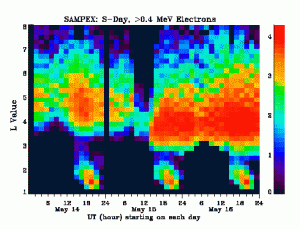Radiation belt electrons: magnetic storm of 1997
In order to probe the physical mechanisms for large radiation belt intensity enhancements during geomagnetic storms, variations in 0.2-3.2 MeV electron flux in the magnetosphere during the May 15, 1997 magnetic storm (the largest magnetic storm of 1997) have been examined using data from SAMPEX, GPS series of satellites, and LANL sensors on geosynchronous orbit.
As shown in the accompanying figure during the main phase of the storm near 12:00 on May 15, fluxes of >0.4 MeV electrons from SAMPEX decreased at L>4.5 following the Dst drop but increased somewhat at L<<4. GPS satellite data also show that the electron flux decreased in the energy range 0.2-3.2 MeV for all L values above the minimum detectable L value of 4.2 simultaneously with the decrease in Dst, consistent with an adiabatic process. But the recovery of the electron flux was different at different energies with an earlier recovery of the less energetic electrons and a later recovery of the more energetic electrons. The recovery of the electron fluxes started before the recovery of Dst, indicating that non-adiabatic processes were involved. The 0.2-0.8 MeV electrons appeared in the low L region (4.2-4.5) at about the same time that the GOES-9 spacecraft measured a strong dipolarization of the Earth's stretched magnetic field. However, the radial gradient of the phase space density of more energetic electrons in the same region for a given first adiabatic invariant was estimated to be negative as a function of radial distance during the time when the more energetic electron flux was increasing. Detailed analysis by SAMPEX investigators suggests that another process, such as local heating, which does not conserve the first adiabatic invariant, may be required to explain the subsequent enhancement of the more energetic (0.8-3.2 MeV) electrons. This work has been accepted for publication in Journal of Geophysical Research [Li et al., JGR, 1999].
Contributed by Xinlin Li, LASP, UNiversity of Colorado, Boulder
«Return to the Results page
